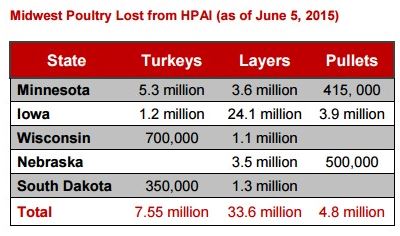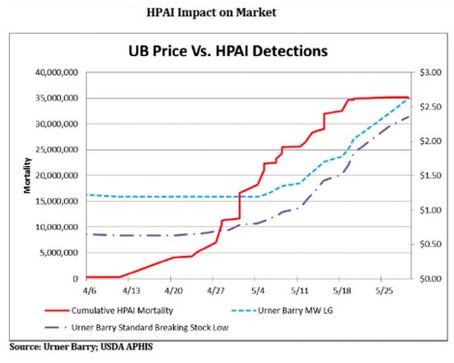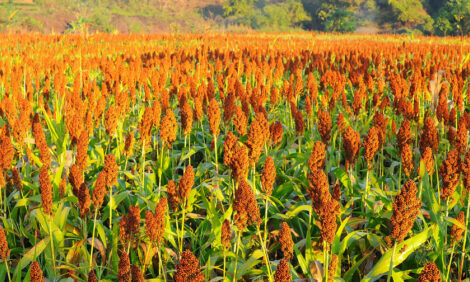



How Can US Poultry Producers Protect Flocks from Avian Flu Threat?
US - Outbreaks of highly pathogenic avian influenza (HPAI) serotype H5N2 appear to be slowing in the US, but the potential for new outbreaks as migrating birds move south in autumn is high, reports Eric Gingerich, DVM (Technical Specialist in Poultry, Diamond V).Higher seasonal temperatures are helping, along with growth of vegetation – corn and soybeans growing in fields around poultry houses – which helps to reduce movement of dust carrying virus particles.
However, during summer, migratory waterfowl flyways intermingle in the Arctic, so with the coming of autumn and the return of infected birds, resurgence in H5N2 outbreaks is likely. It can become a perennial national threat.
The unprecedented losses of Midwestern poultry producers so far this year have been horrendous. The loss of turkeys has amounted to about 3.1 per cent of the US annual production. For layers, the loss has been about 11.2 per cent of the US population of layers as of March 2015. Five Midwestern states have been hit the worst (table).
As HPAI spread, egg production and inventories declined and prices began to rise steeply at the end of April (chart).
Also, according to the UDSA’s monthly turkey hatchery report released last week, turkey eggs in incubators were down 5 per cent and poults were down 8 per cent from last year.
How are officials destroying and disposing of birds on infected premises?
To prevent further spread of the disease, proper disposal of birds from infected premises is necessary.
When an infected premise is confirmed, the flocks surrounding the infected premise within 6.2 miles are surveyed for evidence of the virus as well as any dangerous contacts (feed mill routes, crew activity, and so on).
Flock movement from this area requires several negative tests and permission from the USDA incident commander before issuance of a movement permit. Movement of eggs requires daily testing of mortality from each flock on a premise along with assurance that there are no clinical signs of avian influenza before a permit is given.
On infected farms, depopulation of turkeys is mostly done by using fire-fighting foam. In some cases with older birds, it has been difficult to obtain enough foam to cover the heads of these tall birds, especially if they are able to stand on other dead birds.
For layers or pullets, the modified atmosphere killing (MAK) carts are used as a means of applying the fire-fighting foam in cages, although the technique has not been perfected as yet.
Some delays in depopulation result from a lack of a supply of carbon dioxide that is used for euthanasia in these carts. Also, this process is rather time consuming and cumbersome, which can delay the death of these virus-producing birds. A much quicker method is needed to euthanise these birds and stop them shedding virus.
Disposal of a huge amount of dead birds is a monumental task. All means of disposal are being utilised: burial, incineration, composting, and landfills. The most common means of disposal for turkeys is composting in the house.
For layers, it is not possible to compost birds in cage layer houses without pits. So, producers are using burial, incineration, transport to landfills, and composting on fields.
Re-population of an infected premise cannot take place until the premise has undergone complete cleaning and disinfection, has tested negative for virus, and has passed a 21-day waiting period. In addition, all flocks in the surveillance zone must be eligible for repopulation as well.
How can producers keep avian flu out of their flocks?
Enhanced biosecurity and resistance-building tactics used by producers to keep HPAI out of their flocks include the following practices.
Air, water, feed:
- Making doors air-tight so that contaminated dust cannot get pulled in from outside;
- Placement of medium grade filters over air inlets to filter out dust;
- Increasing the level of chlorine or iodine water sanitizer to reduce potential contamination in the oropharyngeal cavity;
- Feeding formaldehyde-based feed additives in an effort to reduce risk of grain or feed contamination; and
- Feeding Original XPC™ in order to improve respiratory viral resistance – an increased feeding rate of 2.5 lb/ton (normal level for layers is 1.5 lb/ton) may help to improve resistance.
Disinfection:
- Fogging disinfectant on the grounds outside of entryways and walls to reduce viral load there;
- Placing air ionizing rods (electrostatic precipitation – ESP units) or ionizing light fixtures in air inlet systems to reduce dust borne contamination;
- Fogging chicken-friendly disinfectant daily or more often in air inlets and plenum areas in an effort to reduce any windborne virus that may have entered the air system;
- Cleaning and applying disinfectant to inside floors around doorways where people enter or where outside air may be pulled in due to the negative pressure built up by exhaust fans; and
- Daily cleaning and disinfection of walkways throughout the house.
Workers:
- Strictly adhering to a policy restricting all workers persons working in chicken areas from entering egg processing areas – most desirable is a separate entryway away from egg processing;
- Considering areas of houses undergoing bird movement with crew traffic as potential areas of contamination – if workers must walk through, then take precautions by sanitizing footwear and hands;
- Requiring from all crews a “Certificate of Compliance” (COC) for moving birds that states what is expected – for example, crew members will either use the on-farm clothing supplied or arrive at work in clean clothing, footwear, headgear, etc. and will not have been in other poultry operations for 48 to 72 hours prior to coming to work, etc.;
- Requiring that once crews for moving birds enter through the entryway system, they do not leave the building without going through the entryway process again;
- Improving the entryways for visitors and employees to establish zones differentiating between dirty and clean; removing street clothing and footwear, washing hands and face, then donning on-farm clothing and footwear; and
- Requiring that no one leaves the house and re-enters without going through the entire entryway system.
Truck drivers and others:
- Forbidding truck drivers from entering poultry houses;
- Providing built-in automatic tyre and wheel well wash stations at the entries to farms or complexes;
- Requiring that feed truck drivers remain in their cabs, while providing a worker to operate the hoppers and delivery auger or boom on the truck – and using a similar system for gas deliveries;
- Requiring that egg pickup drivers remain in their cabs, while providing workers to load the truck;
- Requiring a COC for transport equipment stating the equipment (including the tractor, trailers, racks, coops, kill carts, etc.) are cleaned and disinfected according to an agreed upon method prior to use of the farm; and
- Applying free-flying bird repellent to premises and buildings.
Innovation for future disease protection
The recent HPAI outbreaks are generating innovative approaches to enhance biosecurity, especially under conditions where the contamination is present just outside the poultry house.
Here are some future biosecurity interventions:
- Feed trucks with wireless controlled farm bin opening systems, in-cab trailer bin openers, and camera assisted booms that are directed from the cab;
- “Ozonation” of air in the poultry house intake system;
- UV-C light air sanitation of incoming air;
- Filtration of incoming air using high efficiency particulate arrestance (HEPA) filters or a combination of medium grade filtration and electrostatic precipitation (ESP) dust removal systems;
- Chimney air intakes to obtain fresh air from well above the ground level;
- Use of positive air pressure in poultry houses to push pathogens out of the house rather than pull them in as with our present negative pressure systems;
- Smaller egg laying complexes; and
- Site selection to avoid contamination from neighbouring farms.
But biosecurity alone is not stopping this beast of a virus.
Vaccination is an option, depending on whether USDA determines that it can help reduce the number of outbreaks, thereby making more efficient use of our eradication resources.
Vaccination is going to mean a different monitoring system than in the past. The new system is likely to be based on sentinel bird use or antigen detection rather than on serology.










